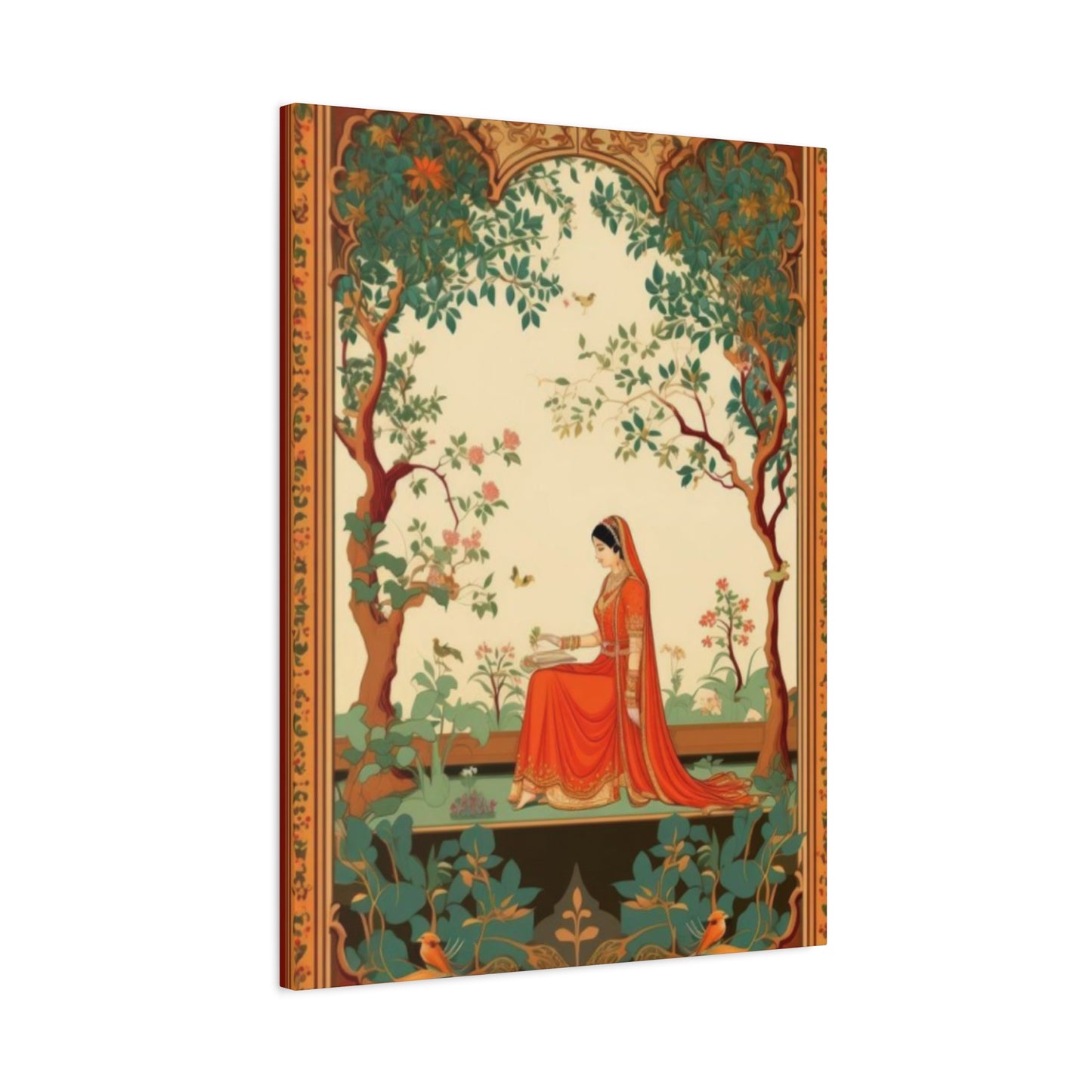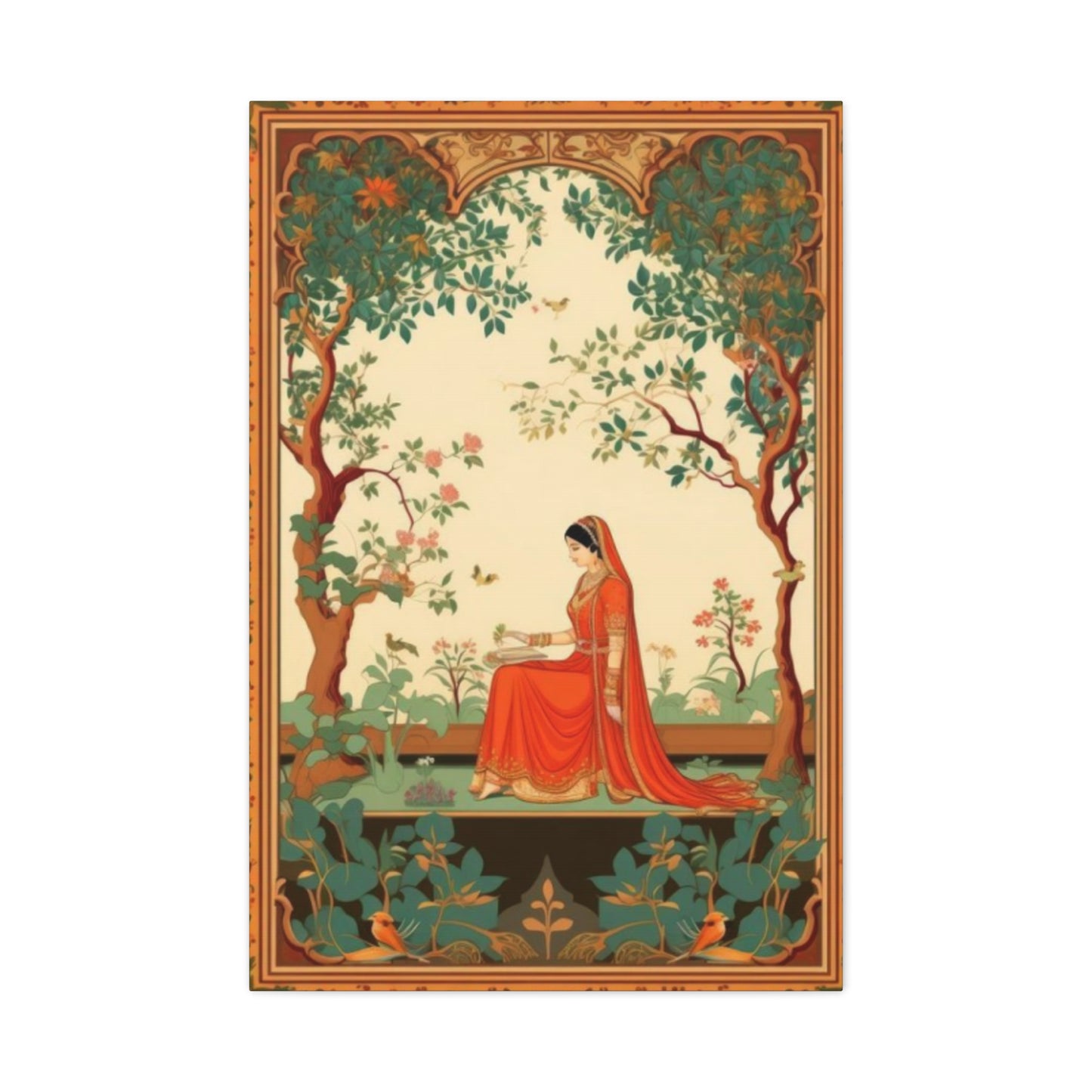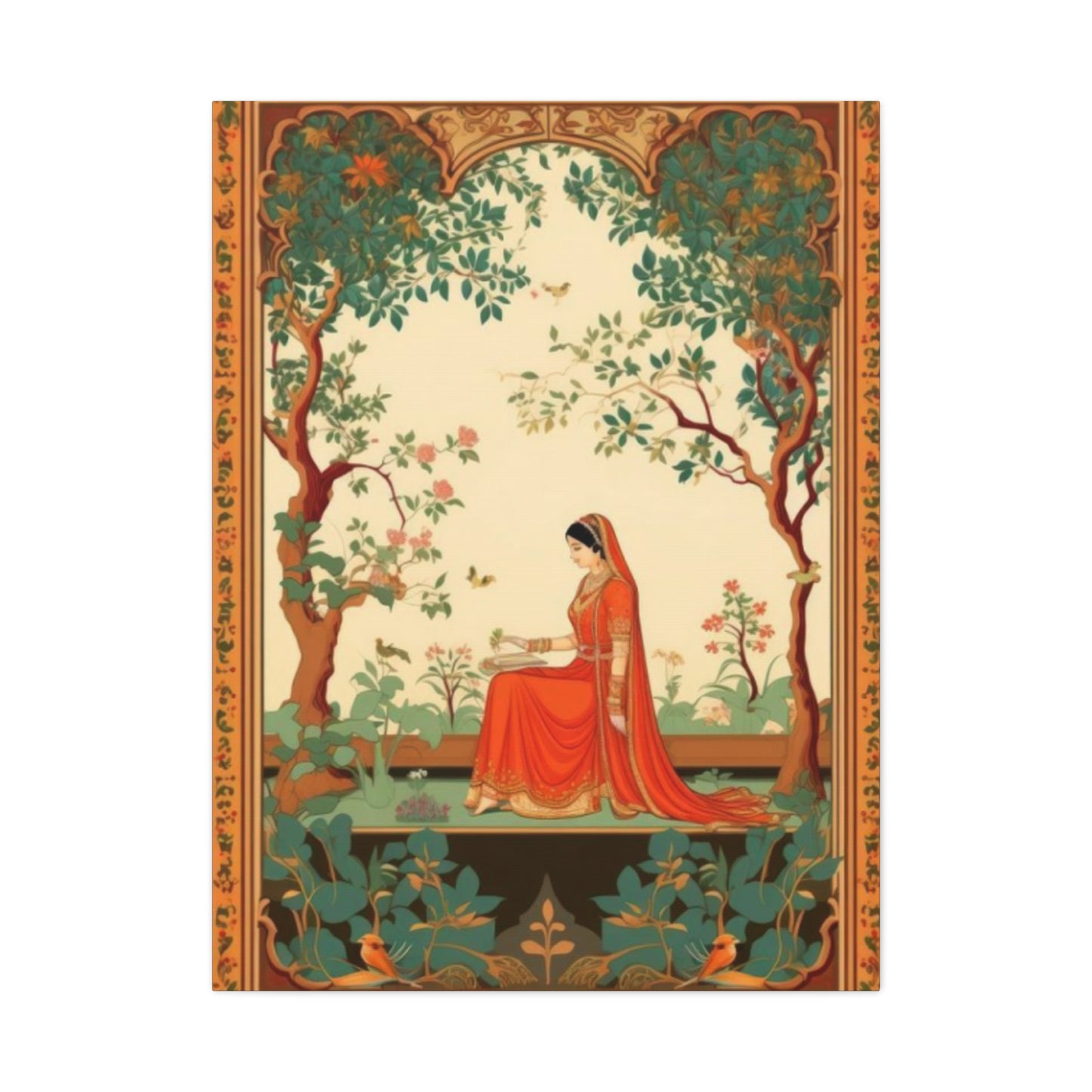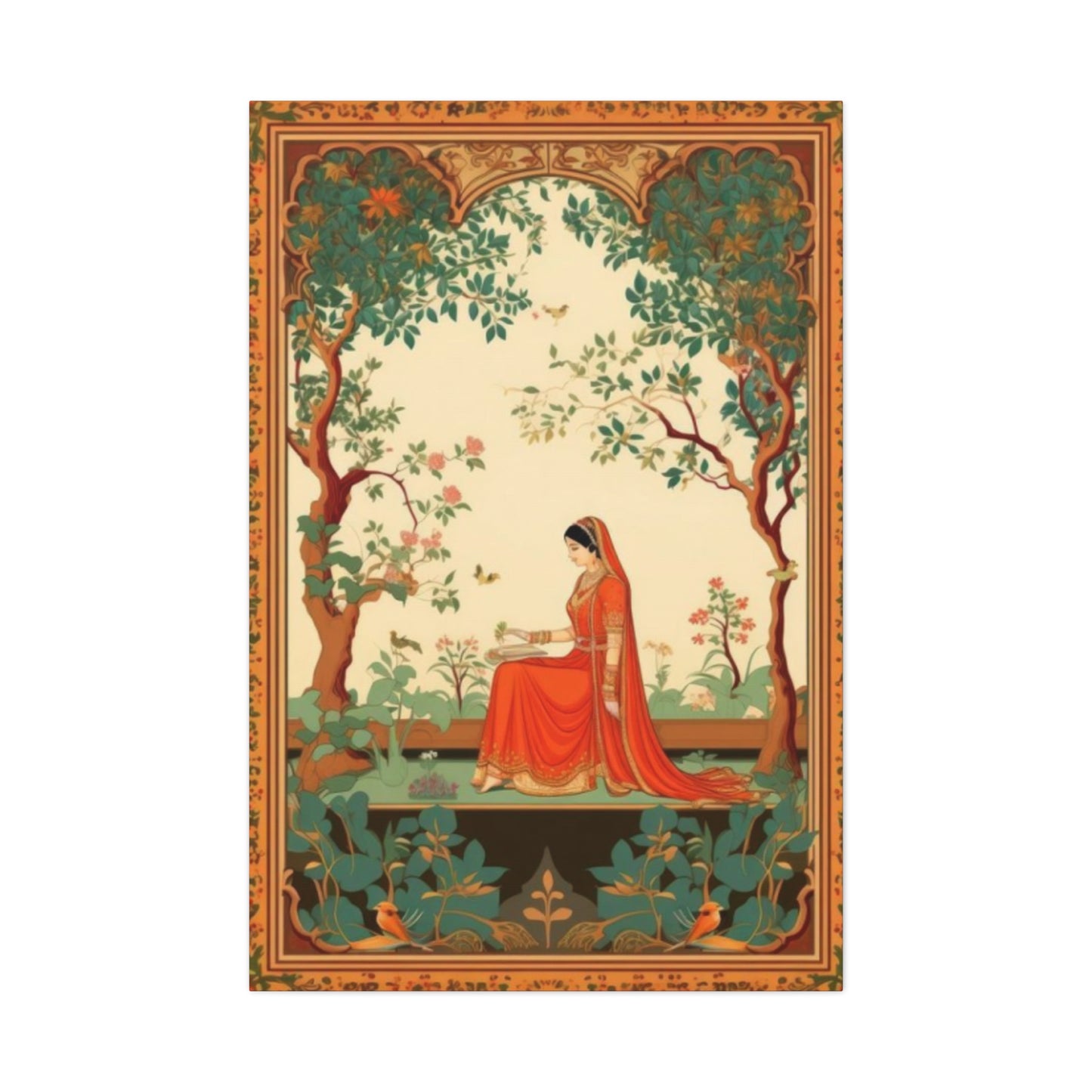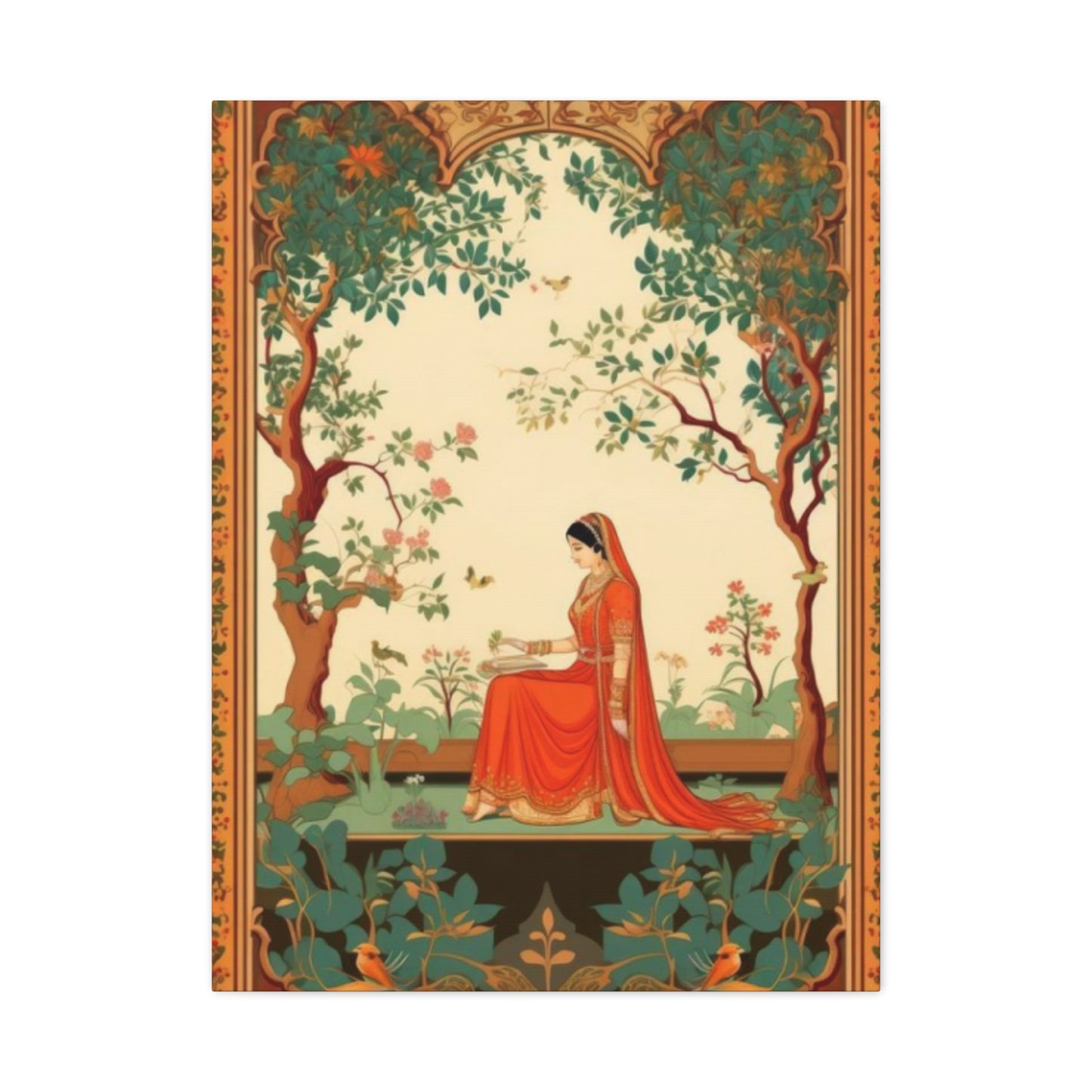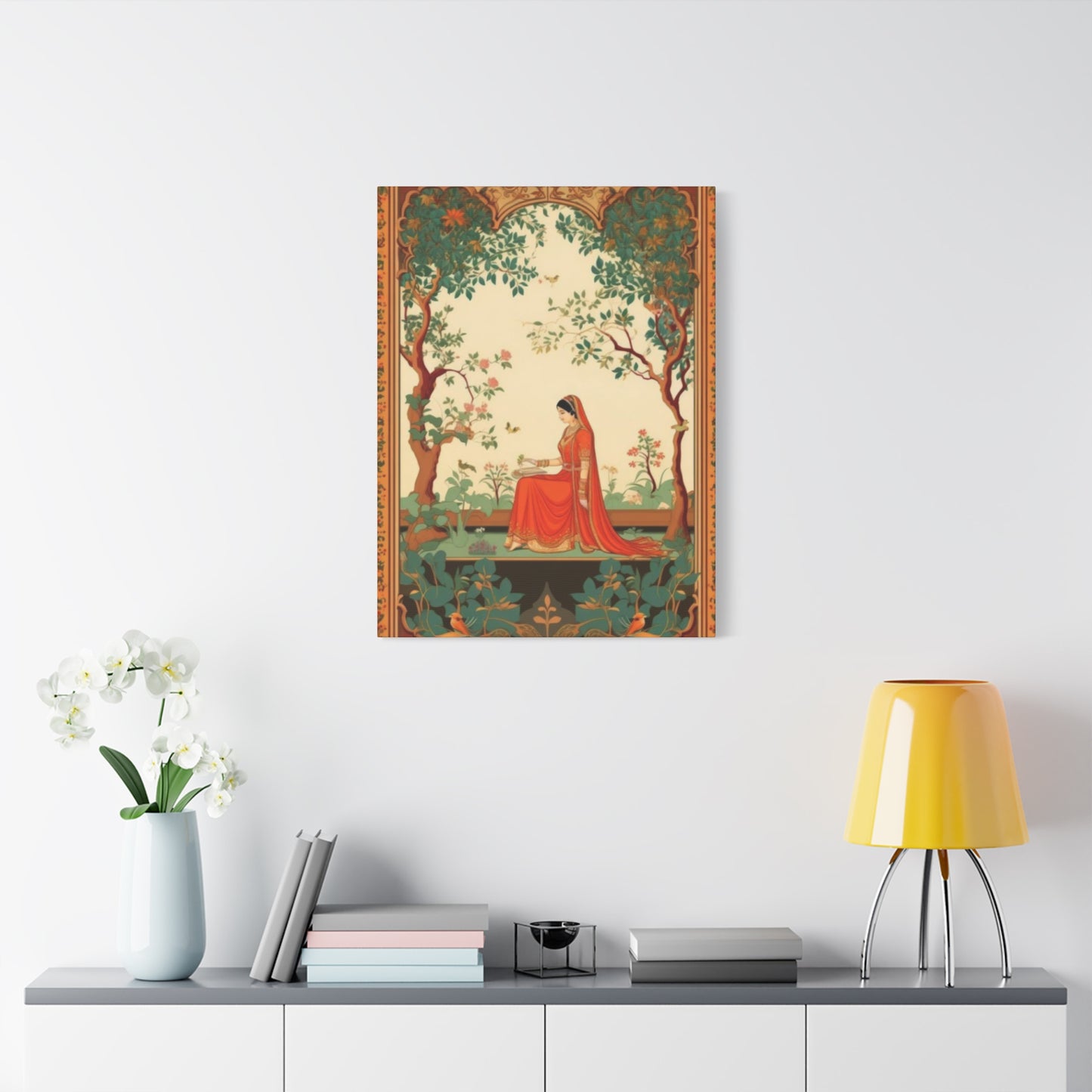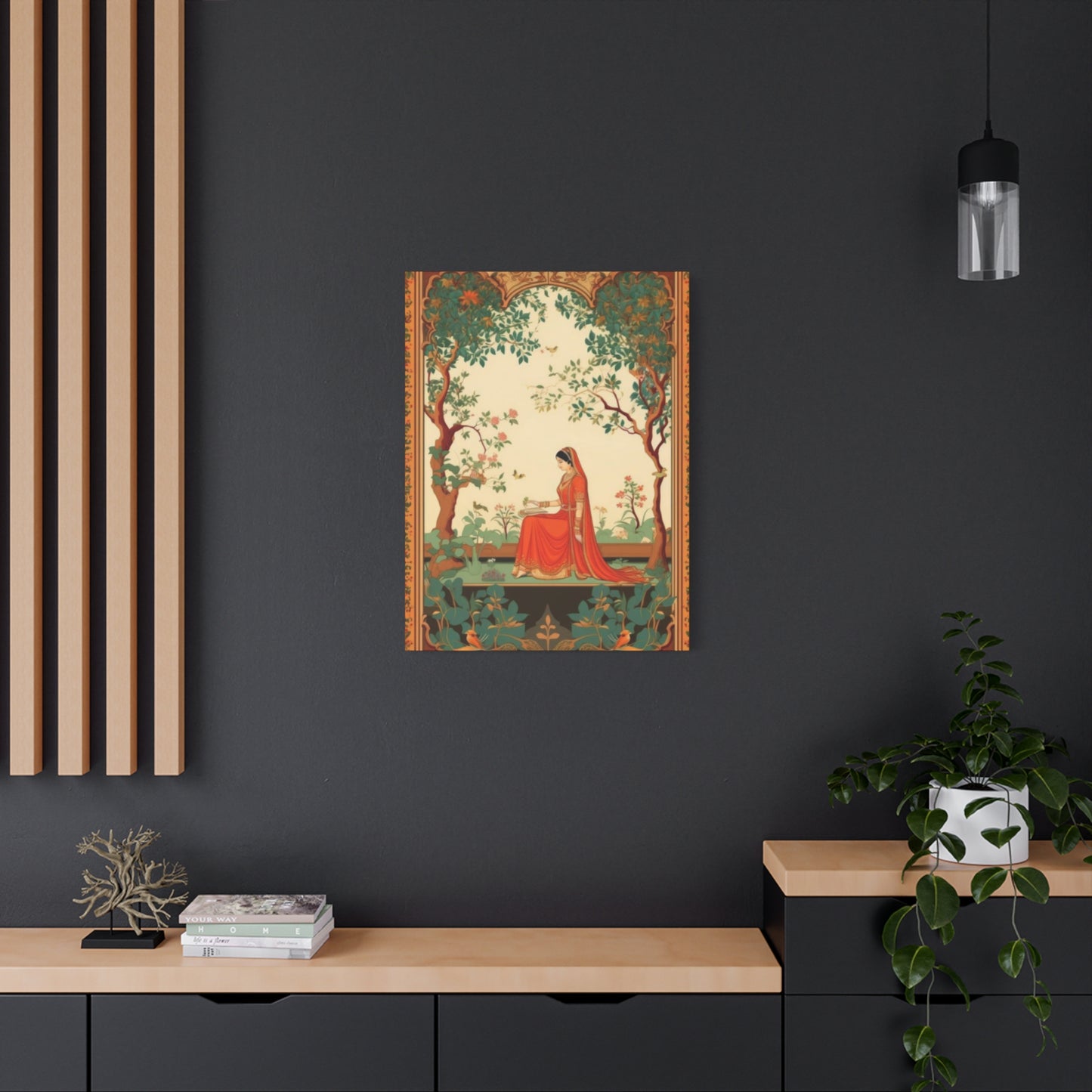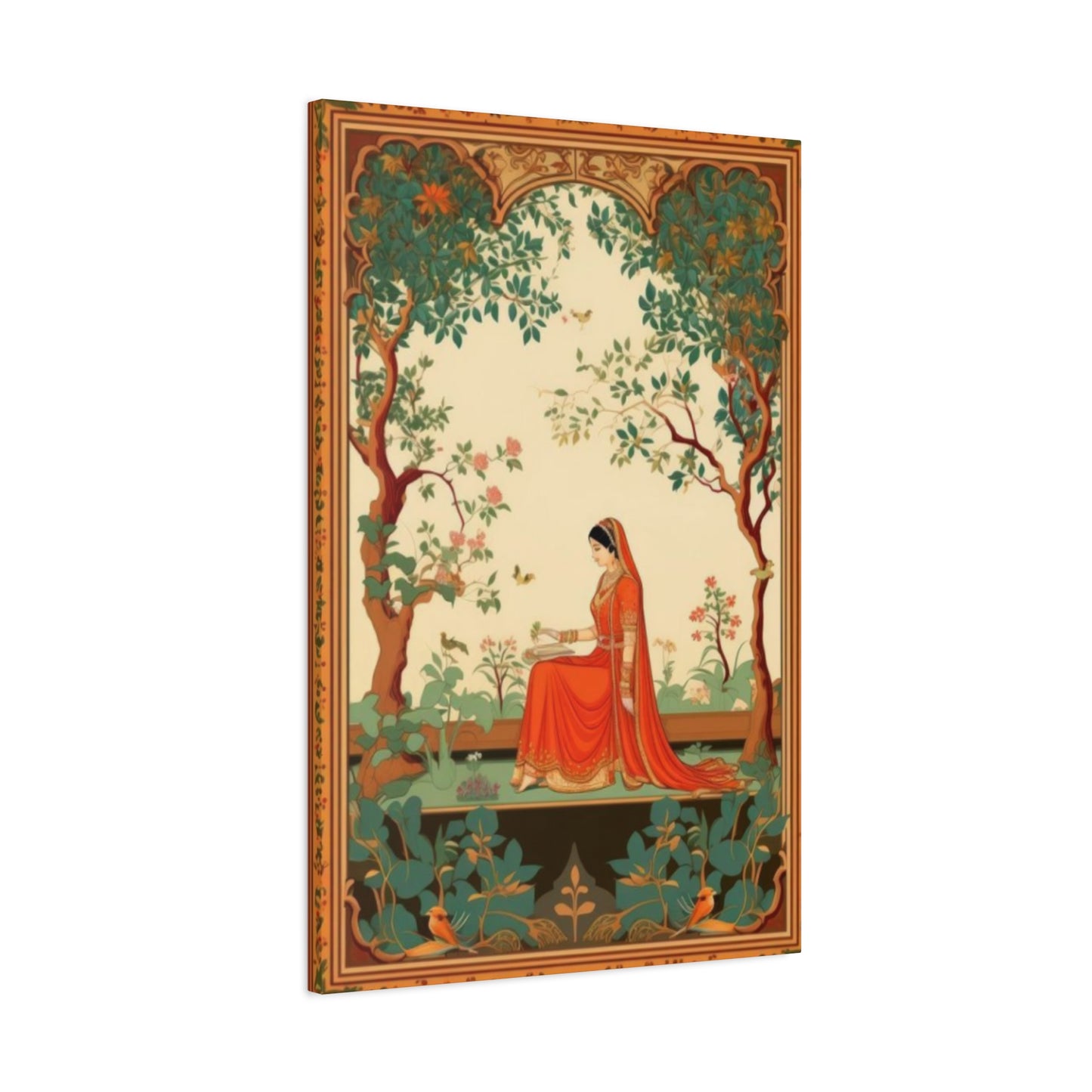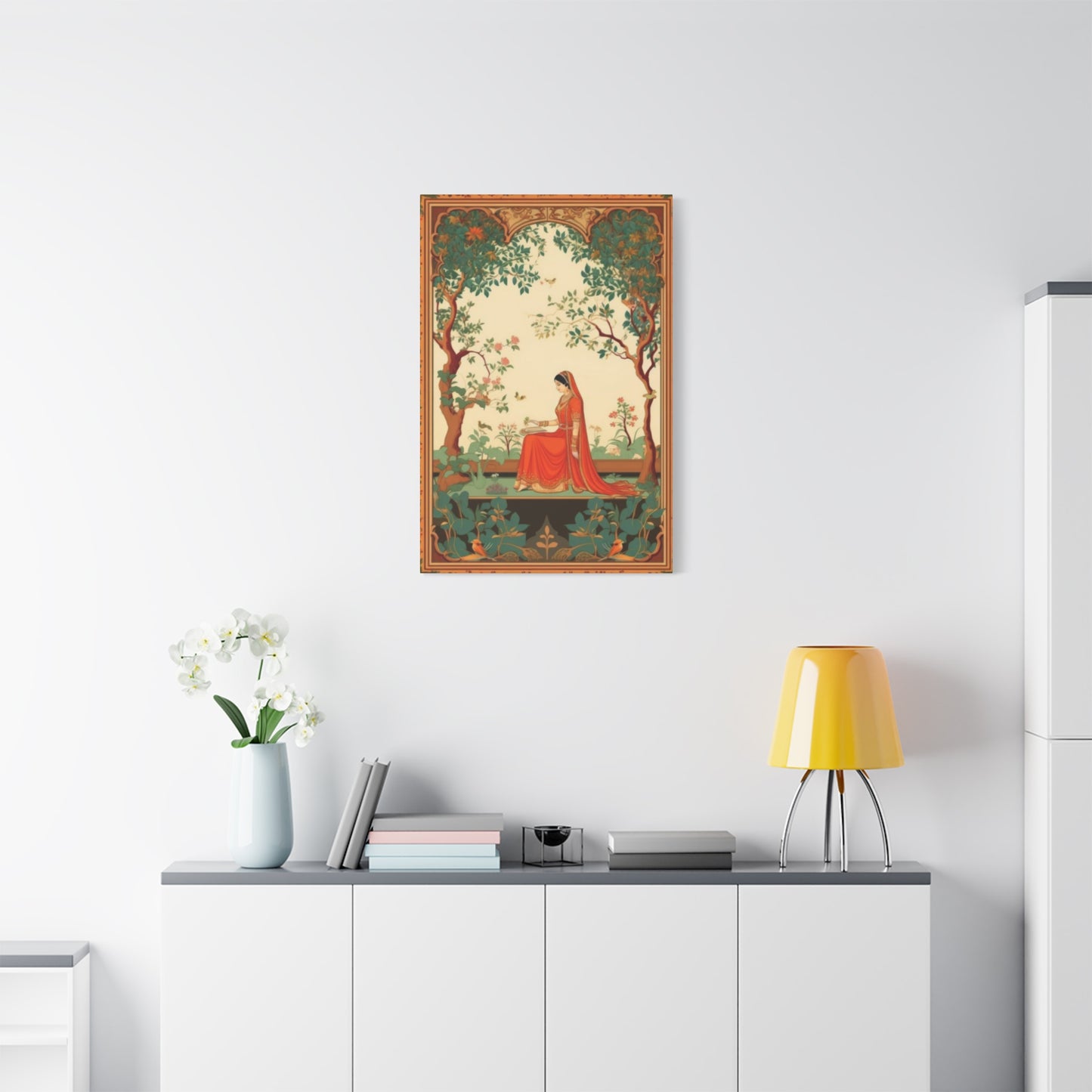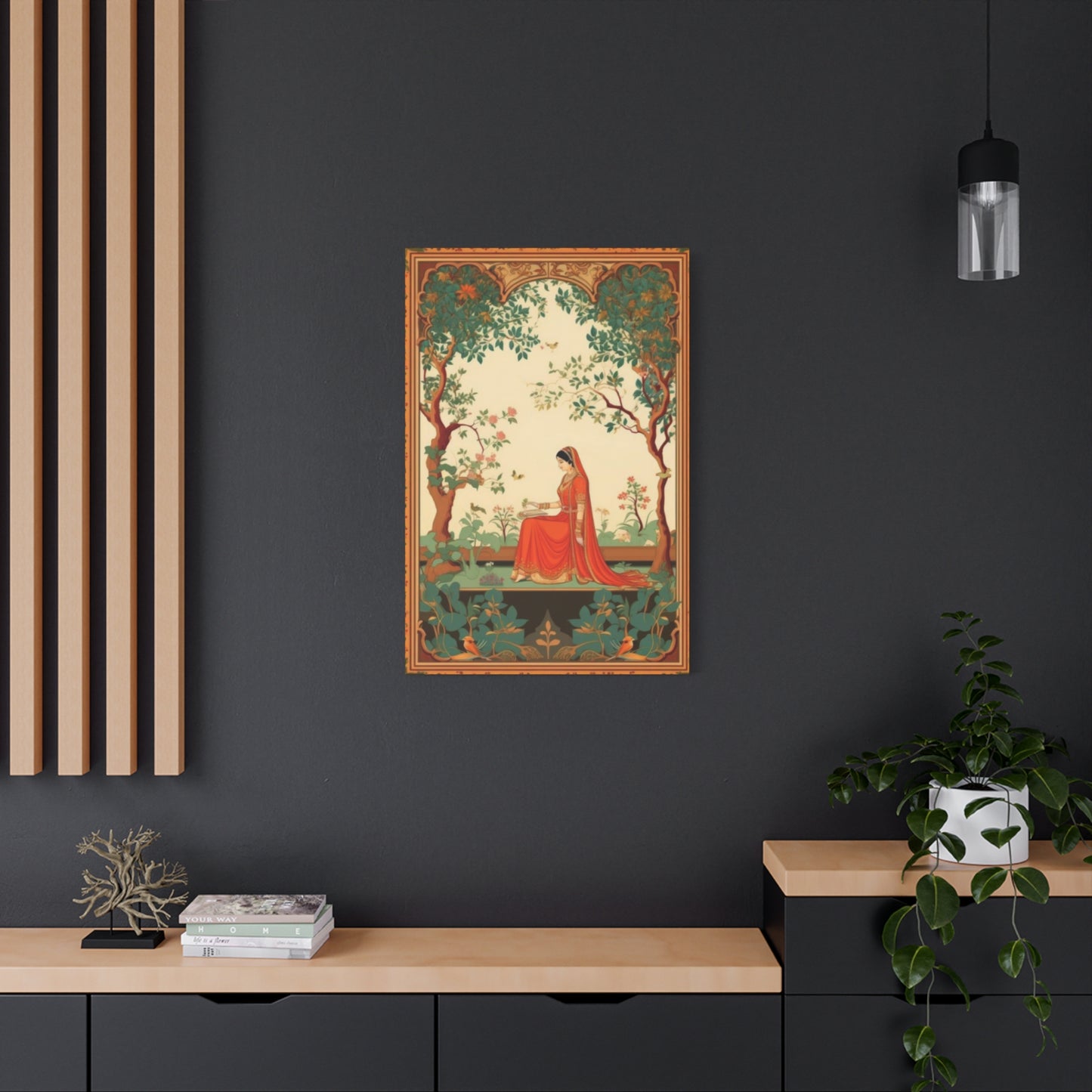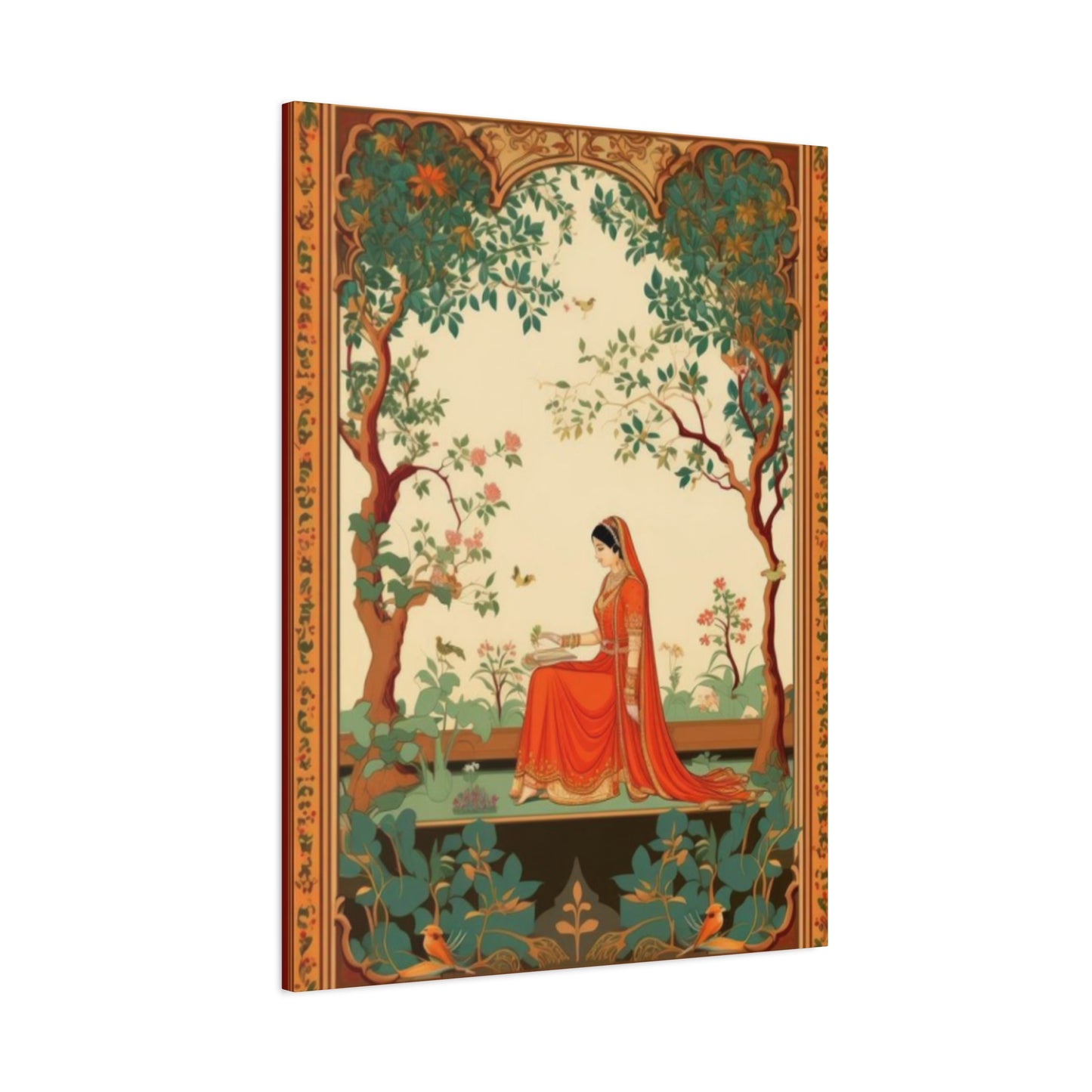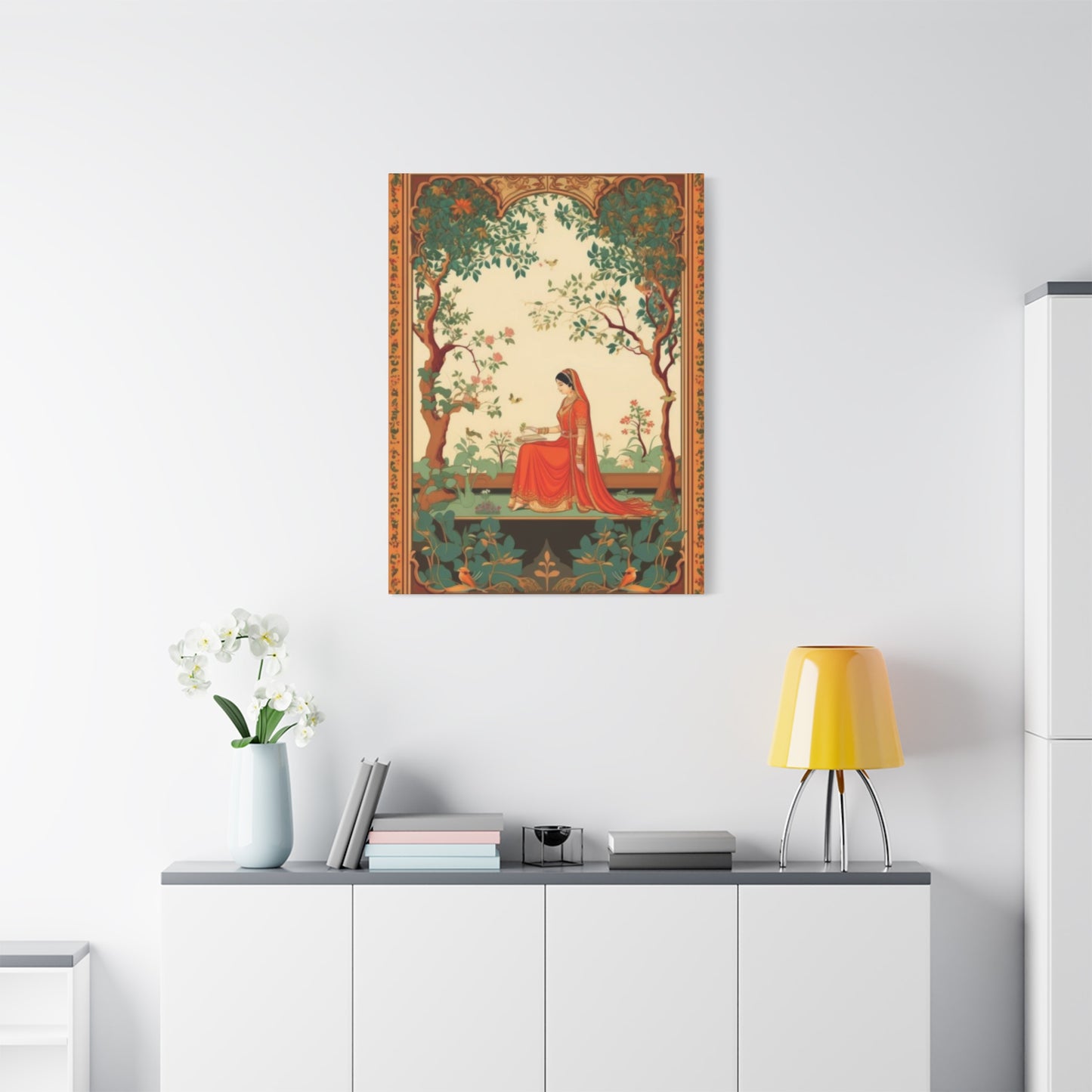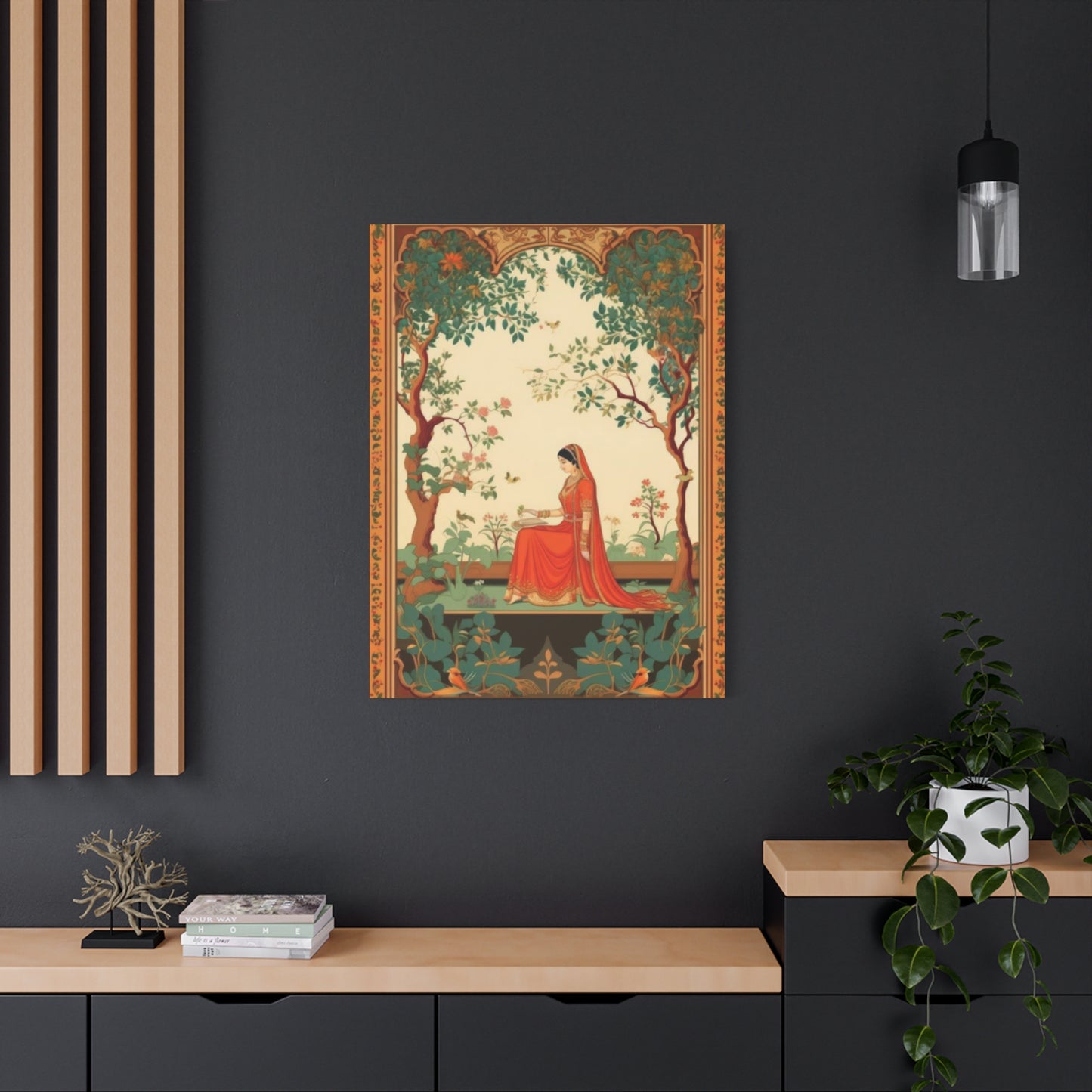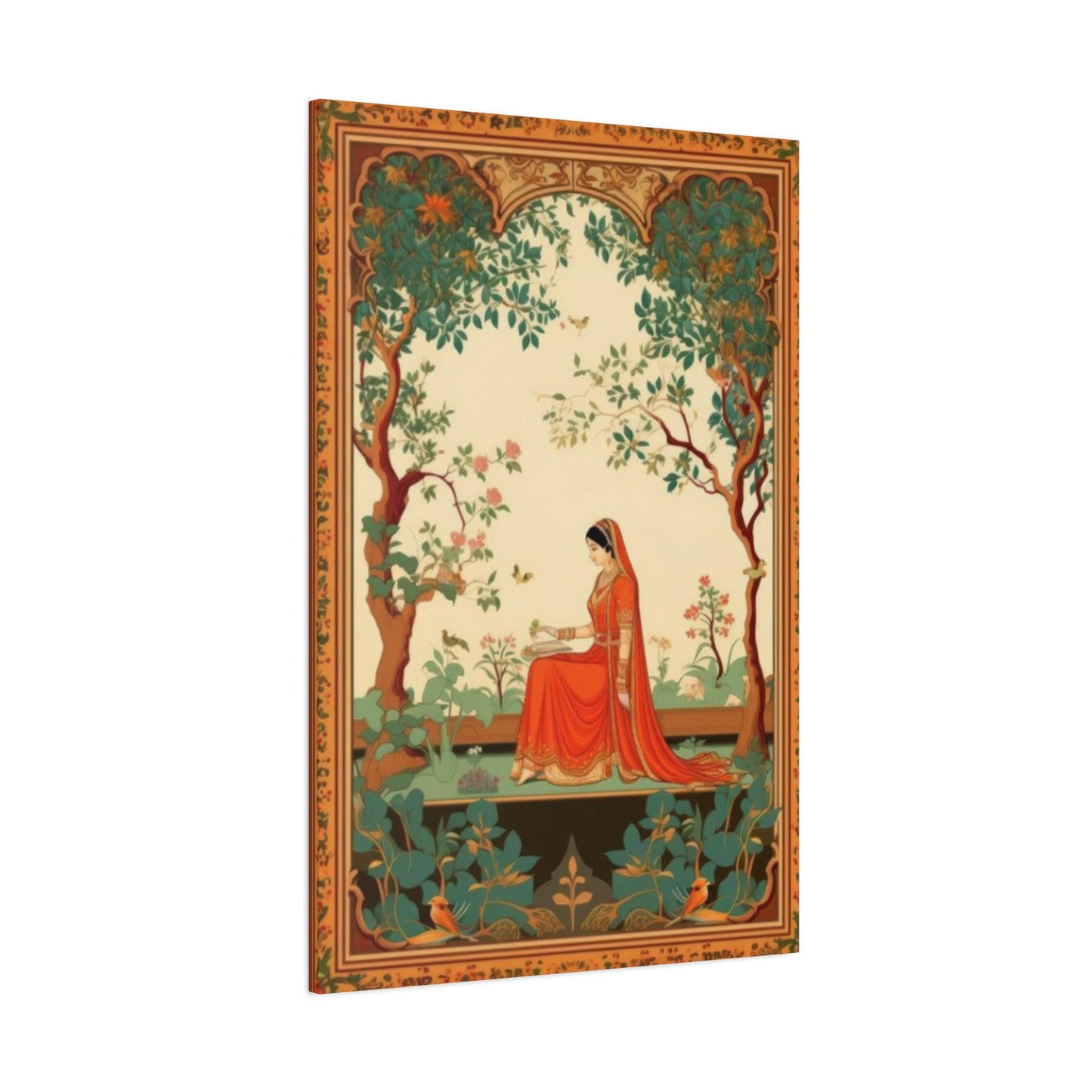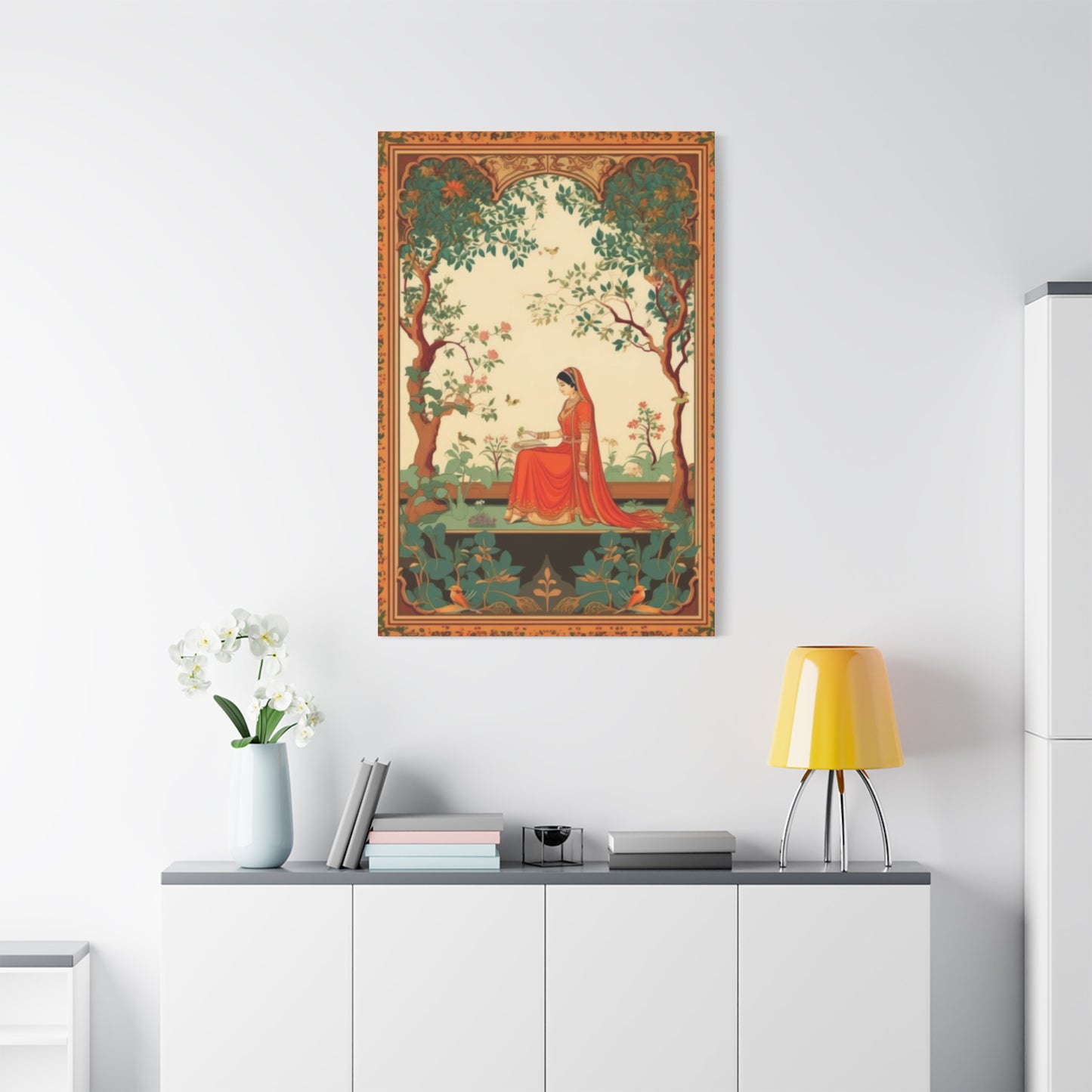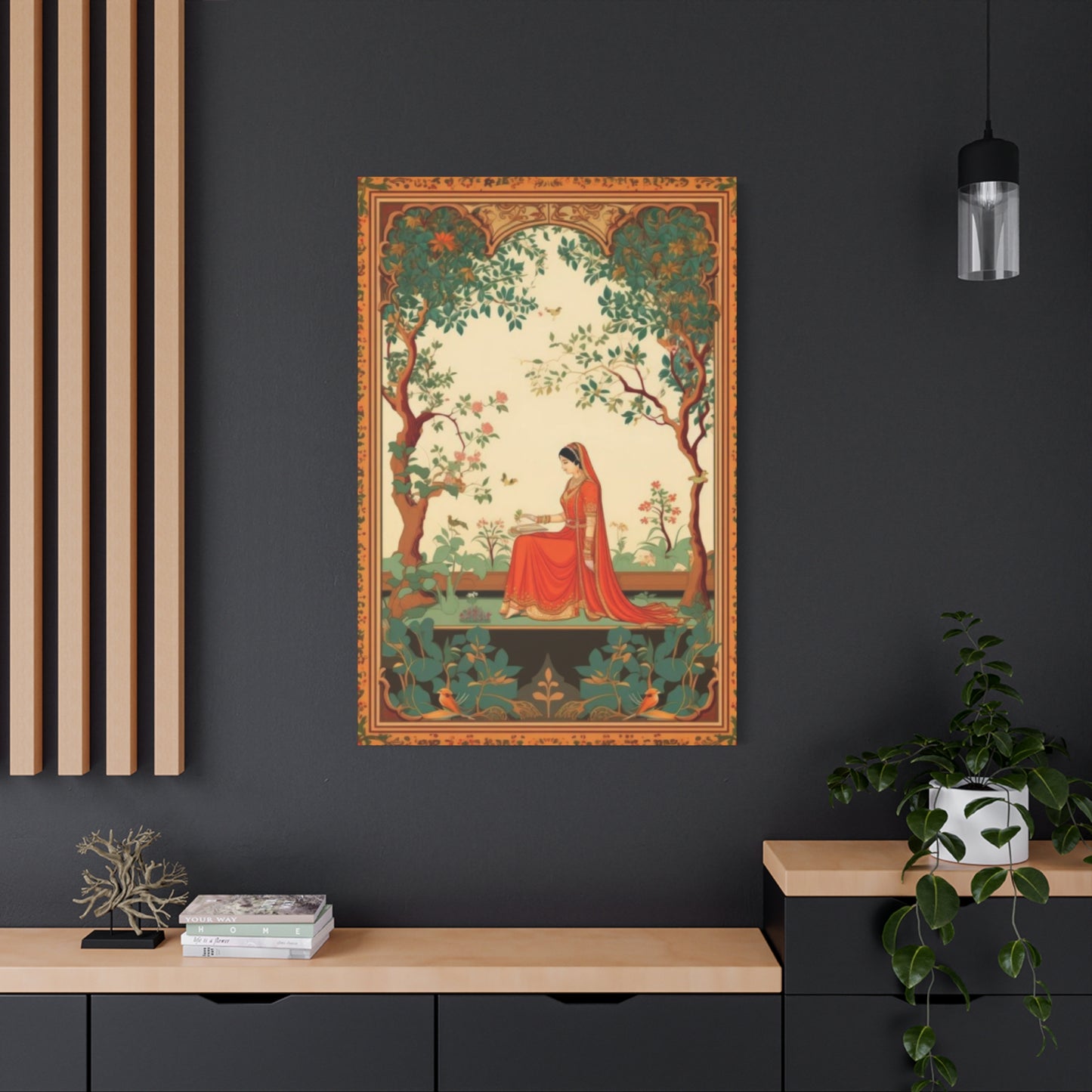Captivating Indian Women Wall Art: Celebrating Cultural Heritage Through Visual Storytelling
The mesmerizing world of Indian women portrayed in traditional attire through wall art represents one of the most enchanting forms of cultural expression. These artistic creations capture the essence of femininity wrapped in centuries-old traditions, showcasing the timeless elegance of Indian culture. Traditional Indian women's attire encompasses a vast spectrum of garments, from the graceful saree to the vibrant lehenga, each piece telling a unique story of regional heritage and cultural significance.
Artists specializing in traditional attire wall art focus on intricate details that make each piece authentic and meaningful. The draping of a saree, the delicate pleats, the way the pallu falls gracefully over the shoulder - every element is carefully rendered to honor the original beauty of these garments. The color palettes chosen for such artworks often reflect the rich dyes and fabrics traditionally used in Indian textiles, incorporating deep maroons, royal blues, emerald greens, and golden yellows that speak to the opulence of Indian craftsmanship.
The artistic representation of traditional Indian women goes beyond mere clothing; it encompasses the entire cultural context surrounding these garments. Artists often incorporate traditional jewelry, elaborate hairstyles, and ceremonial accessories that complete the authentic portrayal. The mehndi patterns adorning hands and feet, the bindis marking foreheads, and the traditional nose rings all contribute to creating a comprehensive visual narrative that celebrates Indian femininity.
Contemporary artists have found innovative ways to present traditional attire through modern artistic techniques while maintaining cultural authenticity. Mixed media approaches combining watercolors with gold leaf, digital art merged with traditional painting methods, and contemporary canvas treatments all serve to bring these timeless subjects into modern living environments. This fusion allows homeowners to celebrate their cultural heritage while maintaining contemporary aesthetic sensibilities.
The emotional resonance of traditional attire wall art extends beyond visual appeal, connecting viewers to ancestral memories and cultural pride. Many collectors find themselves drawn to these pieces as a way of maintaining connection to their roots, especially those living away from their homeland. The artwork serves as a bridge between generations, allowing cultural values and appreciation for traditional beauty to pass from parents to children through visual storytelling.
Graceful Portraits of Indian Women
Graceful portraits of Indian women in wall art capture the inherent elegance and poise that characterizes feminine beauty in Indian culture. These artistic representations go beyond surface aesthetics to explore the deeper qualities of grace, dignity, and strength that define Indian womanhood. The portraiture style allows artists to focus intensely on facial expressions, gestures, and subtle details that convey personality and character.
The art of portraying grace in Indian women requires understanding of traditional poses and expressions that have been refined over centuries through classical dance forms, sculpture, and religious art. Artists draw inspiration from Bharatanatyam mudras, classical sculpture poses found in ancient temples, and traditional painting styles like Tanjore and Mysore paintings. These influences help create portraits that feel authentically rooted in Indian artistic tradition while speaking to contemporary sensibilities.
Color selection plays a crucial role in conveying grace through portraiture. Soft, muted tones often dominate these works, creating an atmosphere of serenity and refinement. Artists frequently employ techniques like subtle gradation and gentle blending to achieve the smooth, porcelain-like skin tones traditionally associated with beauty in Indian art. The background treatments are typically kept minimal to ensure focus remains on the subject's graceful presence.
Lighting techniques in graceful portraiture often draw from traditional Indian art forms where divine figures are depicted with subtle halos or gentle illumination. Modern artists interpret this concept through sophisticated shading and highlighting techniques that create an ethereal quality around their subjects. This approach helps viewers connect with the spiritual and transcendent aspects of feminine grace in Indian culture.
The market for graceful portrait wall art has expanded significantly as collectors seek artwork that brings a sense of calm and elegance to their living environments. These pieces work particularly well in bedrooms, meditation rooms, and areas designated for quiet reflection. The graceful presence depicted in such artwork creates an atmosphere conducive to peace and contemplation.
Contemporary interpretations of graceful Indian women portraits often incorporate modern artistic techniques while maintaining traditional sensibilities. Digital art platforms have allowed artists to experiment with lighting effects, color gradations, and textural elements that were previously difficult to achieve through traditional media. This technological advancement has opened new possibilities for creating wall art that captures grace in innovative ways.
Folk Art Inspired Indian Women Prints
Folk art traditions across India provide rich inspiration for contemporary wall art featuring Indian women. Each region of India has developed distinct folk art styles over centuries, from Madhubani paintings of Bihar to Warli art of Maharashtra, Pattachitra of Odisha to Kalamkari of Andhra Pradesh. These traditional art forms offer unique visual languages for depicting women that are both culturally authentic and artistically distinctive.
Madhubani-inspired prints featuring Indian women incorporate the characteristic bold lines, vibrant colors, and intricate patterns that define this ancient art form. Women in these artworks are often depicted surrounded by nature motifs, geometric patterns, and symbolic elements that tell stories of daily life, festivals, and mythological narratives. The fish, birds, and lotus flowers that frequently accompany female figures in Madhubani art carry deep cultural significance related to prosperity, love, and purity.
Warli art interpretation brings a minimalist approach to depicting Indian women through simple geometric forms and monochromatic color schemes. The characteristic stick-figure style of Warli art, when applied to feminine subjects, creates powerful silhouettes that emphasize movement and community connections. These prints often show women engaged in traditional activities like dancing, farming, or participating in village celebrations.
Pattachitra-inspired wall art featuring Indian women draws from the rich mythological traditions of Odisha. These prints often depict women as goddesses, dancers, or mythological figures, rendered in the distinctive style characterized by strong outlines, bold colors, and decorative borders. The stories told through these artworks connect viewers to ancient narratives while celebrating feminine power and beauty.
Contemporary artists working in folk-inspired styles often combine elements from multiple regional traditions to create unique fusion pieces. A single artwork might incorporate Madhubani color palettes with Warli geometric forms, or blend Pattachitra storytelling techniques with Kalamkari natural dye aesthetics. This fusion approach creates wall art that honors traditional folk art while appealing to modern sensibilities.
The accessibility of folk art inspired prints has made them popular choices for those seeking to add cultural depth to their homes without the investment required for original folk artworks. High-quality prints capture the essence of traditional techniques while making these cultural treasures available to a broader audience. Digital printing technologies have advanced to the point where even the subtle textural elements of traditional folk art can be faithfully reproduced.
Modern Indian Woman Canvas Decor
The contemporary representation of Indian women in canvas decor reflects the evolving role of women in modern Indian society while maintaining connections to cultural heritage. Modern Indian woman canvas art celebrates the multifaceted nature of today's Indian women - professionals, entrepreneurs, artists, and leaders who navigate between traditional values and contemporary aspirations.
Artists creating modern Indian woman canvas decor often focus on themes of empowerment, independence, and urban sophistication while incorporating subtle cultural elements. These artworks might show women in contemporary clothing with traditional jewelry, or in professional attire with cultural symbols integrated into the background. The challenge lies in creating pieces that feel current and relevant while honoring cultural identity.
Urban cityscapes frequently serve as backgrounds for modern Indian woman canvas art, reflecting the reality that many contemporary Indian women live and work in metropolitan environments. Artists might depict women against skylines of cities like Mumbai, Delhi, or Bangalore, creating a visual dialogue between individual identity and urban culture. These compositions speak to themes of ambition, progress, and the changing landscape of opportunities for women in India.
Color palettes in modern Indian woman canvas decor tend to be more diverse and experimental than traditional representations. Artists might employ bold contemporary colors alongside traditional Indian hues, creating dynamic contrasts that reflect the complexity of modern Indian identity. Neon accents, metallic elements, and unconventional color combinations help these artworks feel fresh and current.
The portrayal of modern Indian women often includes contemporary accessories and symbols of achievement. Laptops, smartphones, diplomas, and professional attire become artistic elements that tell stories of women's advancement in various fields. These contemporary elements are often balanced with traditional cultural symbols to create a comprehensive picture of modern Indian womanhood.
Digital art techniques have become particularly popular for creating modern Indian woman canvas decor. The flexibility of digital media allows artists to experiment with layering, transparency effects, and mixed media approaches that can be challenging to achieve with traditional painting methods. This technological approach often resonates with the modern themes being explored in the artwork itself.
Cultural Beauty in Indian Female Portraits
The concept of beauty in Indian culture encompasses far more than physical appearance, extending to include spiritual radiance, cultural grace, and inner strength. Wall art that captures cultural beauty in Indian female portraits attempts to convey these multidimensional aspects of attractiveness through visual elements that resonate with Indian aesthetic traditions.
Classical Indian beauty standards, as depicted in ancient sculptures and traditional paintings, emphasize features like large, expressive eyes, graceful hand positions, and serene facial expressions. Contemporary artists working in this tradition study these classical representations to understand the visual language that has been used for centuries to convey feminine beauty in Indian culture.
The integration of cultural symbols into portraits of beautiful Indian women adds layers of meaning to these artworks. Elements like lotus flowers, peacock feathers, traditional patterns, and religious symbols are woven into compositions to create portraits that celebrate not just individual beauty but cultural identity. These symbols carry deep significance in Indian tradition and help viewers connect with cultural values.
Jewelry representation in cultural beauty portraits requires particular attention to detail and authenticity. Traditional Indian jewelry styles vary significantly by region, community, and occasion, and artists must understand these nuances to create culturally accurate representations. The intricate patterns of temple jewelry, the elaborate designs of Rajasthani ornaments, and the delicate filigree work of different regional traditions all require specialized knowledge to portray accurately.
Textile patterns incorporated into portraits of culturally beautiful Indian women often draw from traditional fabric designs that carry cultural significance. Banarasi silk patterns, Kanjeevaram motifs, Bandhani tie-dye designs, and block print patterns from various regions of India are frequently integrated into backgrounds or clothing representations to add authenticity and cultural depth.
The spiritual dimension of beauty in Indian culture often manifests in portraits through subtle elements like gentle lighting, serene expressions, and symbolic backgrounds. Artists might incorporate temple architecture, natural elements like flowing water or blooming flowers, or abstract spiritual symbols to suggest the connection between outer beauty and inner spirituality that is valued in Indian culture.
Women with Sarees Wall Art
The saree, as India's most iconic garment, provides endless inspiration for wall art celebrating Indian women. The six to nine yards of fabric that comprise a saree offer artists opportunities to explore color, pattern, texture, and movement in ways that few other subjects allow. The draping styles, regional variations, and cultural significance of sarees make them compelling subjects for artistic interpretation.
Regional saree styles offer diverse artistic possibilities, from the heavy silk Kanjeevaram sarees of South India to the delicate cotton sarees of Bengal, each carrying distinct visual characteristics that artists can explore. The border patterns, pallu designs, and draping styles specific to different regions provide authentic details that add cultural accuracy to artistic representations.
The movement and flow of saree fabric present particular challenges and opportunities for artists. Capturing the way silk cascades, how cotton catches light, or the way a pallu flows in a breeze requires understanding of fabric behavior and advanced artistic techniques. Artists must master the depiction of different textile weights, transparencies, and textures to create convincing saree representations.
Color combinations in saree wall art often draw from traditional textile dyeing techniques and regional preferences. The rich color stories found in traditional Indian textiles - combinations like peacock blue with emerald green, deep maroon with gold, or sunset orange with magenta - provide artists with sophisticated palettes that have been refined over centuries of textile craftsmanship.
Pattern work on saree representations requires detailed study of traditional textile design motifs. Paisley patterns, floral vines, geometric designs, and mythological figures that commonly appear on Indian textiles must be accurately rendered to maintain authenticity. Artists often specialize in particular pattern styles, developing expertise in Banarasi brocade work, Kanjeevaram temple borders, or Chanderi floral motifs.
The emotional and cultural significance of sarees in Indian women's lives adds depth to wall art featuring these garments. Artists often seek to capture moments of significance - a bride's wedding saree, a mother's festival attire, or a grandmother's treasured silk - that resonate with viewers' personal experiences and cultural memories.
Indian Brides in Decorative Paintings
Bridal imagery holds special significance in Indian culture, representing not just personal celebration but cultural continuity and family honor. Wall art featuring Indian brides in decorative paintings captures the elaborate beauty, ceremonial significance, and emotional depth of this important life transition through rich visual narratives.
Traditional bridal attire varies significantly across different Indian communities, providing artists with diverse visual vocabularies to explore. A Punjabi bride's heavy lehenga and elaborate jewelry differs dramatically from a Bengali bride's red and white saree ensemble, while a South Indian bride's silk saree and temple jewelry creates yet another distinct artistic subject. Understanding these regional differences is crucial for creating authentic bridal art.
The symbolism incorporated into bridal decorative paintings often draws from traditional marriage ceremonies and cultural beliefs about matrimony. Elements like mangalsutra, sindoor, mehendi patterns, and ceremonial flowers carry deep significance in Indian wedding traditions. Artists weave these symbolic elements into their compositions to create artworks that celebrate not just bridal beauty but the cultural institution of marriage itself.
Color symbolism plays a particularly important role in Indian bridal art. Red, traditionally associated with prosperity and fertility, dominates many bridal representations, but artists also incorporate gold for wealth and happiness, green for new beginnings, and yellow for knowledge and learning. The sophisticated understanding of color meaning in Indian culture allows artists to create emotionally resonant works through thoughtful color choices.
Decorative elements in bridal paintings often mirror the elaborate preparations that characterize Indian weddings. Intricate henna patterns, elaborate hairstyles adorned with flowers and jewelry, and the layers of ceremonial clothing all provide opportunities for detailed artistic work that celebrates the care and attention given to bridal presentation in Indian culture.
Contemporary interpretations of Indian brides in decorative paintings sometimes blend traditional elements with modern artistic techniques. Mixed media approaches, contemporary color palettes applied to traditional subjects, and fusion elements that reflect modern Indian weddings help these artworks appeal to contemporary collectors while maintaining cultural authenticity.
Elegant Silhouettes of Indian Women
The art of silhouette has found particular expression in depicting Indian women, where the characteristic poses, garment draping, and cultural gestures create instantly recognizable and deeply evocative forms. Elegant silhouettes of Indian women in wall art strip away details to focus on essential forms and movements that capture the essence of Indian feminine grace.
Classical dance forms provide rich source material for elegant Indian women silhouettes. The precise hand positions of Bharatanatyam, the flowing movements of Kuchipudi, the expressive gestures of Kathak, and the dramatic poses of Mohiniyattam all translate beautifully into silhouette art. These dance-inspired silhouettes carry cultural significance while creating visually striking wall art.
The draping of traditional garments creates distinctive silhouettes that are uniquely Indian. The way a saree pallu falls over the shoulder, how a dupatta frames the female form, or the bell shape created by a traditional lehenga all produce recognizable and culturally specific silhouettes. Artists working in this style must understand these garment characteristics to create authentic representations.
Jewelry and accessories often remain visible in elegant silhouette art, serving as identifying details that provide cultural context. The shape of traditional earrings, the outline of elaborate necklaces, or the suggestion of bangles and anklets help viewers connect silhouettes to specific cultural traditions and regional styles.
Background elements in silhouette wall art frequently incorporate architectural details or natural motifs that provide cultural context without competing with the main subject. The outline of temple domes, traditional window designs, or stylized natural elements like lotus flowers or peacocks create atmospheric backgrounds that enhance the cultural resonance of the silhouettes.
Modern interpretations of Indian women silhouettes sometimes incorporate contemporary elements while maintaining traditional grace. Urban skylines, modern architectural elements, or contemporary accessories might be suggested in silhouette form, creating artworks that speak to the experience of modern Indian women while celebrating traditional aesthetics.
Tribal Women Art for Boho Environments
Tribal art traditions from various indigenous communities across India offer unique perspectives on depicting women that align beautifully with bohemian decorating styles. These artistic traditions, developed over centuries in various tribal communities, bring authentic cultural elements and distinctive visual approaches to contemporary wall art.
Gond art traditions from Madhya Pradesh provide one approach to tribal women art, characterized by intricate patterns, nature-inspired motifs, and distinctive dot-and-line techniques. Gond artists traditionally depicted women as integral parts of natural ecosystems, surrounded by animals, trees, and natural phenomena that reflect the deep connection between tribal communities and their environment.
Bhil art from Gujarat and Rajasthan offers another distinctive approach to depicting tribal women through bold, simplified forms and vibrant colors. The characteristic stick-figure style of Bhil art creates powerful and direct representations that emphasize community connections and traditional activities rather than individual portraiture.
Sohrai and Khovar art traditions from Jharkhand provide approaches to depicting women that emphasize geometric patterns and earth-tone color palettes. These art forms traditionally decorated homes during harvest festivals and wedding celebrations, creating visual languages specifically designed to honor feminine roles in agricultural and family life.
Color palettes in tribal women art often draw from natural pigments and dyes traditionally used by indigenous communities. Earth tones, ochres, natural whites, and colors derived from plants and minerals create authentic color stories that align well with bohemian decorating preferences for natural and organic elements.
The thematic content of tribal women art frequently focuses on daily activities, community celebrations, and connections to nature that resonate with bohemian lifestyle values. Women gathering water, participating in community dances, working in fields, or caring for children are common subjects that celebrate authentic ways of living.
Contemporary artists creating tribal-inspired women's art for bohemian environments often study traditional techniques while adapting them for modern wall art applications. This might involve scaling up traditional motifs, adapting color palettes for contemporary homes, or combining elements from different tribal traditions to create unique fusion pieces.
Madhubani-Style Women Wall Prints
Madhubani art, also known as Mithila painting, offers one of India's most recognizable and beloved approaches to depicting women in folk art. Originating in the Mithila region of Bihar, this ancient art form provides a rich visual vocabulary for creating contemporary wall prints that celebrate Indian women through traditional artistic methods.
The characteristic elements of Madhubani art - bold outlines, intricate patterns, vibrant colors, and symbolic motifs - create a distinctive aesthetic that translates beautifully to contemporary wall art. Women in Madhubani style are often depicted with large, expressive eyes, elaborate hairstyles, and surrounded by nature motifs that tell stories about their roles in family and community life.
Traditional Madhubani color palettes rely heavily on natural pigments, creating distinctive color combinations that include deep reds, bright yellows, vivid greens, and rich blues. Contemporary wall prints inspired by Madhubani often maintain these traditional color relationships while adapting them for modern printing techniques and contemporary wall color schemes.
The storytelling aspect of Madhubani art makes it particularly suitable for wall prints that aim to convey cultural narratives. Women in Madhubani art are rarely depicted in isolation; they appear in contexts that tell stories about marriage ceremonies, religious festivals, daily activities, or mythological narratives that connect viewers to cultural traditions and values.
Pattern work in Madhubani-style women wall prints requires careful attention to traditional motifs and their meanings. Fish symbols representing fertility and good luck, peacocks symbolizing love and romance, lotus flowers representing purity, and geometric patterns carrying protective meanings all contribute to the rich symbolic language of this art form.
Contemporary adaptations of Madhubani style for wall prints often involve scaling traditional compositions for modern wall sizes, adapting traditional paper or cloth surfaces for canvas or print media, and sometimes incorporating contemporary elements while maintaining traditional artistic integrity.
Indian Village Women in Art
The portrayal of village women in Indian art celebrates rural life, traditional occupations, and the authentic cultural practices that continue to thrive in India's agricultural communities. These artistic representations often focus on the strength, dignity, and cultural richness found in rural Indian womanhood.
Daily activities of village women provide compelling subject matter for artistic interpretation. Women drawing water from wells, working in fields, grinding grain, tending to livestock, or participating in community gatherings represent authentic aspects of rural life that many urban dwellers find both nostalgic and inspiring.
Traditional occupations specific to rural women offer opportunities for artists to explore cultural practices that might otherwise be forgotten. Women engaged in pottery making, textile weaving, food preparation, childcare, or traditional crafts provide subjects that celebrate skills and knowledge passed down through generations.
The natural environments surrounding village women become integral parts of artistic compositions. Rural landscapes, traditional architecture, agricultural settings, and natural elements like trees, rivers, and fields create contexts that emphasize the connection between rural women and their environment.
Clothing and accessories worn by village women often reflect regional traditions, economic circumstances, and practical needs that differ from urban fashion. Artists depicting village women must understand these differences to create authentic representations that honor the dignity and beauty found in practical, traditional clothing choices.
Color palettes for village women art frequently draw from the natural environment and available materials in rural settings. Earth tones, colors derived from local plants and minerals, and the faded or sun-bleached qualities of clothing worn for practical work create authentic color stories that reflect rural life.
The emotional content of village women art often emphasizes themes of resilience, community connection, and cultural continuity. These women are frequently portrayed as guardians of tradition, keepers of cultural knowledge, and exemplars of strength in the face of challenging circumstances.
Royal Indian Women Portraits
The rich history of Indian royalty provides inspiration for wall art celebrating the elegance, power, and cultural sophistication of royal Indian women. These portraits draw from historical sources, traditional court painting styles, and legendary figures to create artworks that embody luxury, refinement, and cultural prestige.
Historical royal women from various Indian dynasties offer compelling subjects for artistic interpretation. Queens like Rani Padmini of Chittor, Rani Lakshmibai of Jhansi, and Chand Bibi of Ahmednagar provide artists with historically significant figures whose stories combine beauty, courage, and cultural importance.
Court painting traditions from different regional kingdoms provide stylistic frameworks for creating royal women portraits. Mughal miniature painting techniques, Rajasthani court art, Mysore painting styles, and other regional traditions offer distinct approaches to depicting royal subjects with appropriate grandeur and cultural authenticity.
Royal attire and jewelry require particular attention to historical accuracy and artistic detail. The elaborate costumes, precious jewelry, and ceremonial accessories worn by Indian royalty represent some of the finest examples of traditional craftsmanship and design. Artists must research these elements carefully to create convincing royal portraits.
Architectural backgrounds in royal women portraits often incorporate elements from famous palaces, forts, and royal complexes across India. The intricate details of Mughal architecture, the ornate decorations of Rajasthani palaces, and the sophisticated designs of South Indian royal complexes provide appropriate settings for royal subjects.
Color palettes for royal portraits typically emphasize luxury materials and precious elements. Gold leaf applications, rich jewel tones, deep purples and crimsons, and sophisticated color combinations that reflect the wealth and taste of royal courts create appropriate atmospheric qualities for these elevated subjects.
Contemporary interpretations of royal Indian women sometimes blend historical accuracy with modern artistic techniques, creating portraits that honor historical subjects while appealing to contemporary aesthetic sensibilities. This approach allows modern viewers to connect with historical figures through familiar artistic languages.
Indian Women with Floral Themes
The integration of floral motifs with depictions of Indian women draws from deep cultural traditions that associate femininity with nature's beauty, fertility, and life-giving properties. Flowers hold special significance in Indian culture, appearing in religious ceremonies, decorative arts, and literary traditions as symbols of various virtues and qualities.
Lotus flowers, sacred in Indian culture, frequently appear in artworks depicting Indian women. The lotus symbolizes purity, beauty, and spiritual awakening, making it an appropriate motif for feminine subjects. Artists often show women with lotus flowers in their hair, holding lotus blooms, or surrounded by lotus ponds that create serene and spiritually resonant compositions.
Jasmine flowers, traditionally worn in women's hair, provide another popular floral motif for Indian women's art. The delicate white blooms and their association with evening beauty, romance, and traditional feminine adornment make jasmine a culturally appropriate and visually appealing element in artistic compositions.
Marigold flowers, commonly used in Indian festivals and celebrations, often appear in artworks depicting women in celebratory or ceremonial contexts. The bright orange and yellow colors of marigolds add vibrancy to compositions while connecting the artwork to cultural traditions of decoration and celebration.
Rose motifs, while not exclusively Indian, have been adopted into Indian artistic traditions and frequently appear in depictions of women, particularly in Mughal-influenced art styles. Garden settings with rose blooms provide romantic and luxurious contexts for feminine subjects.
Seasonal flowers specific to different regions of India allow artists to create location-specific compositions that reflect local flora and cultural practices. Spring flowers like palash and amaltas, monsoon blooms like kadamba, and winter flowers like chrysanthemums all provide opportunities for culturally and seasonally appropriate floral elements.
Contemporary interpretations of floral themes in Indian women's art sometimes take abstract or stylized approaches to traditional flower motifs, creating modern artworks that maintain cultural connections while appealing to contemporary aesthetic preferences.
Bold Colors in Indian Female Canvas Prints
The use of bold, vibrant colors in depicting Indian women through canvas prints draws from India's rich traditions of textile dyeing, festival celebrations, and artistic expression. Bold color palettes not only create visually striking artworks but also reflect the cultural appreciation for color that characterizes much of Indian art and design.
Traditional Indian color symbolism provides frameworks for meaningful color choices in feminine subjects. Red for prosperity and fertility, yellow for knowledge and learning, green for new beginnings and nature, blue for divinity and infinite possibilities, and purple for luxury and spiritual depth all carry cultural meanings that add layers of significance to artistic compositions.
Festival colors, particularly those associated with Holi (the festival of colors), provide inspiration for creating joyful and celebratory depictions of Indian women. The bright pinks, vibrant oranges, electric blues, and neon greens associated with festival celebrations create energetic and uplifting artworks that capture the spirit of Indian cultural celebrations.
Textile-inspired color combinations drawn from traditional Indian fabrics offer sophisticated palettes for bold canvas prints. The complex color relationships found in Banarasi silks, Rajasthani textiles, South Indian handlooms, and other regional textile traditions provide artists with time-tested color combinations that feel both bold and culturally authentic.
Contemporary interpretations of bold color usage sometimes blend traditional Indian color preferences with modern artistic techniques like gradient effects, color blocking, or abstract color applications that create striking visual impacts while maintaining cultural resonance.
The psychological impact of bold colors in Indian female canvas prints often aims to create feelings of joy, celebration, empowerment, and cultural pride. These artworks are frequently chosen for locations where energetic and uplifting atmospheres are desired.
Digital printing technologies have made it possible to achieve bold, saturated colors that were previously difficult to reproduce consistently. This technological advancement has opened new possibilities for creating vibrant Indian women's art that maintains color intensity over time.
Spiritual Indian Woman Wall Art
The spiritual dimension of Indian womanhood has deep roots in the country's religious and philosophical traditions. Wall art depicting spiritual Indian women draws from various traditions including Hinduism, Buddhism, Jainism, and Sufism to create images that celebrate the divine feminine and women's roles in spiritual life.
Goddess representations provide one approach to spiritual Indian woman wall art. The rich tradition of goddess worship in Hinduism offers numerous divine feminine figures - Durga, Lakshmi, Saraswati, Kali, and others - each with distinct attributes, colors, and symbolic associations that provide frameworks for spiritual artworks.
Devotional poses and gestures common in Indian spiritual traditions frequently appear in spiritual women's art. Prayer positions, meditation poses, ritual gestures, and expressions of devotional surrender create compositions that invite contemplation and spiritual reflection.
Sacred symbols and geometric patterns often accompany spiritual depictions of Indian women. Om symbols, lotus mandalas, yantra patterns, and other spiritual motifs provide backgrounds or decorative elements that enhance the spiritual atmosphere of these artworks.
Temple art influences provide stylistic guidance for creating spiritual women's art that feels authentically rooted in Indian religious traditions. The sculptural traditions found in Hindu, Buddhist, and Jain temples offer approaches to depicting spiritual figures with appropriate dignity and reverence.
Meditation and yoga themes connect spiritual Indian woman wall art to contemporary spiritual practices. Women in meditation poses, practicing yoga asanas, or engaged in spiritual study create artworks that appeal to modern practitioners while maintaining connections to ancient traditions.
Color choices for spiritual Indian woman wall art often emphasize colors associated with spiritual practice: whites for purity, saffron for renunciation, blues for divine consciousness, and golds for spiritual illumination create appropriate atmospheric qualities for contemplative artworks.
Women and Nature: Indian Art Fusion
The relationship between women and nature has been a central theme in Indian art and philosophy for millennia. Contemporary wall art exploring this theme creates fusion pieces that blend traditional cultural concepts with modern artistic techniques to celebrate the connection between feminine energy and natural forces.
Seasonal representations often show Indian women in harmony with different natural cycles. Spring compositions might feature women surrounded by blooming flowers, summer pieces could show women near flowing water, monsoon artworks might depict women dancing in rain, and autumn compositions could feature women with harvest imagery.
Agricultural themes connecting women to food production and land stewardship provide meaningful subjects for nature fusion art. Women planting seeds, tending crops, harvesting grain, or preparing food create narratives that celebrate women's traditional roles in sustaining life and culture.
Water elements frequently appear in women and nature fusion art, reflecting the cultural and practical importance of water in Indian life. Women drawing water from wells, bathing in rivers, or performing water rituals create compositions that explore both practical and spiritual relationships with water.
Tree and forest imagery often accompany depictions of Indian women in nature fusion art. The cultural significance of trees like banyan, neem, and peepal in Indian tradition, combined with forest settings that suggest ancient connections between women and natural wisdom, create rich symbolic compositions.
Wildlife elements including birds, butterflies, and other creatures often accompany women in nature fusion artworks. Peacocks, parrots, and other birds associated with beauty and grace create harmonious compositions that suggest unity between human and animal life.
Contemporary artistic techniques applied to traditional themes of women and nature often employ mixed media approaches, digital manipulation, or abstract elements that create modern interpretations of ancient relationships while maintaining cultural authenticity.
Abstract Indian Female Faces in Decor
Abstract interpretations of Indian female faces in decorative wall art offer opportunities to capture essential qualities of Indian femininity while employing contemporary artistic techniques that emphasize form, color, and emotion over realistic representation. This approach allows artists to explore cultural themes through modern artistic vocabularies.
Geometric abstraction applied to Indian female faces often employs traditional patterns and motifs as building blocks for creating recognizable yet stylized representations. Paisley shapes, mandala elements, and geometric patterns from Indian decorative arts provide frameworks for abstract facial constructions.
Color field techniques applied to Indian female subjects often emphasize the emotional and spiritual qualities associated with different colors in Indian culture. Large areas of spiritually significant colors create atmospheric backgrounds for simplified facial elements that suggest rather than explicitly depict feminine features.
Cubist-influenced approaches to Indian female faces break down facial features into geometric components while maintaining enough recognizable elements to clearly identify the subjects as feminine and culturally Indian. This approach can create striking contemporary artworks that honor cultural subjects through modern artistic methods.
Mixed media approaches to abstract Indian female faces often incorporate traditional materials like gold leaf, natural pigments, or textile elements into contemporary artistic compositions. This fusion of materials creates artworks that bridge traditional and contemporary aesthetic approaches.
Expressionist techniques applied to Indian female subjects emphasize emotional content over realistic representation. Bold brushstrokes, intense colors, and exaggerated features create artworks that capture feelings and impressions rather than accurate likenesses.
Digital art techniques have opened new possibilities for creating abstract Indian female faces that would be difficult to achieve through traditional media. Layering effects, transparency manipulations, and digital texturing allow artists to create complex abstract compositions that maintain clear connections to their cultural subjects.
Indian Women with Jewelry Wall Prints
Traditional Indian jewelry represents some of the world's most sophisticated and culturally significant ornamental arts. Wall art featuring Indian women adorned with traditional jewelry celebrates both feminine beauty and the rich craftsmanship traditions that have developed across different regions and communities in India.
Regional jewelry styles provide diverse opportunities for artistic exploration. Rajasthani jewelry with its elaborate settings and colorful gemstones differs dramatically from the temple jewelry of South India with its religious motifs and gold work, while Bengali jewelry often emphasizes delicate filigree work and cultural symbols specific to Bengal.
Wedding jewelry holds special significance in Indian culture, representing not just personal adornment but family wealth, cultural continuity, and auspicious beginnings. Artists depicting bridal jewelry must understand the symbolic significance of different pieces and their proper usage in various cultural contexts.
Traditional techniques used in Indian jewelry making - kundan setting, meenakari enameling, filigree work, and gem cutting - create distinctive visual characteristics that artists must understand to create convincing representations. The way light plays on different types of jewelry work requires sophisticated artistic techniques to portray accurately.
Religious and spiritual jewelry often appears in artistic depictions of Indian women, including pieces like rudraksha malas, sacred pendants, and jewelry associated with particular deities or spiritual practices. These pieces carry deep cultural significance beyond mere ornamental value.
Contemporary adaptations of traditional jewelry in modern Indian women's art sometimes show fusion approaches where traditional ornamental concepts are interpreted through contemporary design sensibilities while maintaining cultural authenticity and aesthetic appeal.
The symbolic meanings associated with different jewelry pieces - protection, prosperity, marital status, regional identity, and religious devotion - add layers of cultural significance to artworks featuring adorned Indian women.
Grace & Strength: Indian Women in Art
The dual qualities of grace and strength that characterize Indian womanhood provide compelling themes for wall art that celebrates the complexity and depth of feminine identity in Indian culture. These artworks attempt to capture both the gentle, nurturing aspects of femininity and the resilient, powerful qualities that enable women to fulfill their roles as cultural guardians and family pillars.
Historical examples of Indian women who embodied both grace and strength provide artistic inspiration. Queens who led armies while maintaining feminine dignity, spiritual leaders who combined gentle teaching with powerful presence, and social reformers who fought for justice while preserving cultural values offer compelling subjects for artistic interpretation.
Classical dance forms embody the perfect fusion of grace and strength, requiring both physical power and refined elegance. Artists often draw from dance imagery to create compositions that visually represent this duality through body positions that suggest both strength and beauty.
Mythological figures from Indian traditions frequently embody the grace-strength combination. Goddesses like Durga, who combines maternal gentleness with warrior power, provide archetypal models for artistic representations that celebrate both aspects of feminine nature.
Contemporary interpretations of grace and strength themes often show modern Indian women in professional or leadership roles while maintaining traditional elements that connect them to cultural concepts of feminine grace. These compositions create bridges between traditional values and contemporary realities.
Conclusion
Captivating Indian women wall art serves as a profound tribute to the richness of India’s cultural heritage, timeless beauty, and the strength of feminine identity. More than just decorative pieces, these artworks are visual narratives that celebrate tradition, spirituality, grace, and resilience. Each canvas becomes a storyteller, capturing the essence of Indian womanhood through intricate details, vibrant colors, and symbolic elements drawn from centuries of history and culture.
Indian women have long been central figures in mythology, folklore, daily life, and spiritual practice. Wall art that depicts them—draped in flowing sarees, adorned with traditional jewelry, or portrayed in moments of prayer, dance, or reflection—offers a deep and moving glimpse into their roles as nurturers, warriors, artists, and leaders. Through such representations, viewers are invited not only to admire the aesthetic beauty of these works but also to connect with the cultural depth and emotional strength they convey.
From classical paintings inspired by Mughal miniatures and Rajput artistry to modern interpretations using abstract or digital styles, Indian women wall art bridges the past and present. These pieces celebrate diversity across regions, religions, and communities, portraying the multiplicity of identities within Indian womanhood. Whether it's a Rajasthani princess, a Kerala dancer, or a tribal woman from the Northeast, each image offers a unique cultural story wrapped in visual elegance.
In interior spaces, this art brings warmth, identity, and meaning. It serves as a powerful expression of cultural pride and personal connection—particularly for those who seek to keep their roots alive through artistic expression. For collectors and admirers, it becomes more than décor; it’s a reflection of values, heritage, and the quiet strength that Indian women embody across generations.
Furthermore, contemporary Indian artists are reclaiming and redefining these narratives—focusing not just on traditional beauty, but also on empowerment, independence, and modern struggles. This evolution allows the genre to remain dynamic and inclusive, highlighting how Indian women continue to shape society while honoring their ancestral legacies.

















